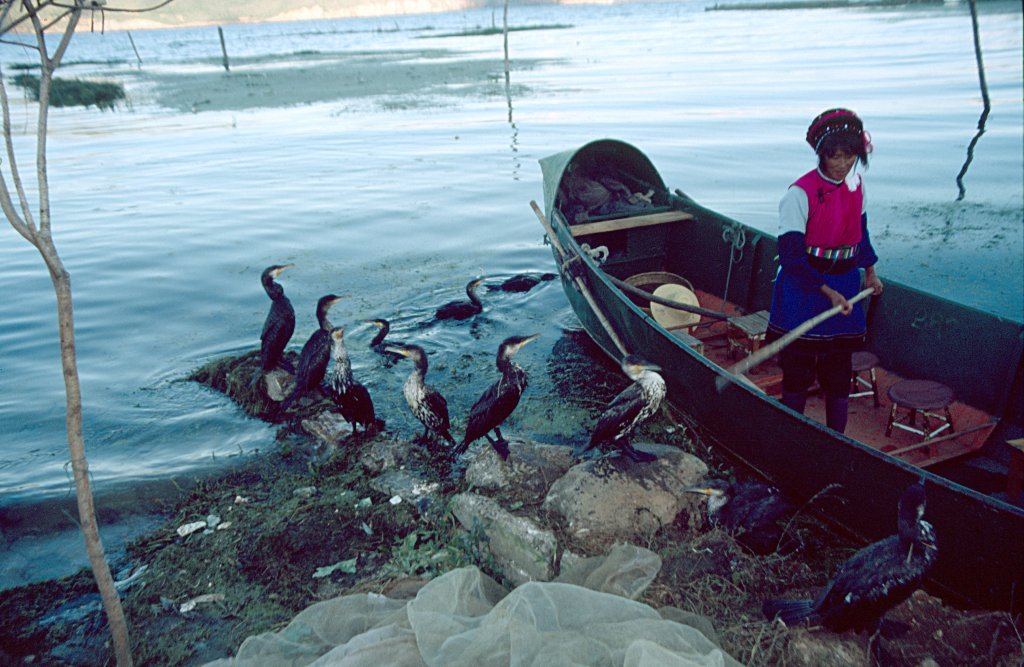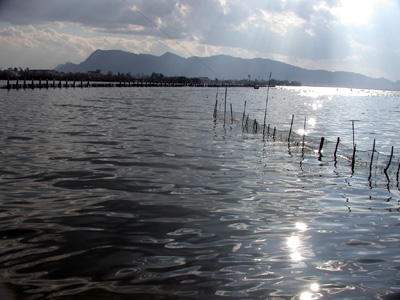|
Erhai
Erhai or Er Lake (), is an alpine fault lake in Dali City, Dali Prefecture, Yunnan province, China. Erhai was also known as Yeyuze () or Kunming Lake () in ancient times. Etymology The character "洱" (er) does not have the same meaning as ear (耳). During the Han to Tang dynasty, there was an ancient ethnic named '' Kunming Yi'' or Kunming Barbarian () lived in the neighbouring region of Erhai lake. Therefore, the lake was also called "Kunming Lake". The ''Kunming Yi'' has another name ''Kun-mi'' (). In the following time, Chinese literature recorded the name "昆弥" as "昆弭" (Kun-mi) that "弭" is a rebus of "弥". And the name of the lake was also changed to the character "渳" (mi) which has a water-meaning radical () attached to it. Fang Guoyu believe the name "洱" (er) was simplified from "渳", after that the name "Erhai" continues to this day. According to Bai scholar's research, the "Yeyu" in the Chinese name "Yeyuze" (''ze'' ��means lake) is evolved from Ba ... [...More Info...] [...Related Items...] OR: [Wikipedia] [Google] [Baidu] |
Dali Prefecture
Dali Bai Autonomous Prefecture ( zh, s=大理白族自治州, p=Dàlǐ Báizú Zìzhìzhōu; Bai: ) is an autonomous prefecture of northwestern Yunnan Province, People's Republic of China. between longitudes 98°52′ to 101°03′ east and latitudes 24°41′ to 26°42′ north, it has a subtropical plateau monsoon climate with distinct dry and wet seasons. Most areas do not experience extreme heat in summer or severe cold in winter, covering a total area of 29,459 square kilometers. By the end of 2023, the permanent population of the Dali Bai Autonomous Prefecture was 3.342 million people. As of March 2023, the Dali Bai Autonomous Prefecture governed one county-level city and 11 counties, with 110 townships, and the People's Government of the Autonomous Prefecture is based in Xiaguan, Dali City. The Dali Bai Autonomous Prefecture has a long history. As far back as the Neolithic Age, the ancestors of ethnic minorities such as the Bai people and Yi people and thrived here. ... [...More Info...] [...Related Items...] OR: [Wikipedia] [Google] [Baidu] |
Yunnan
Yunnan; is an inland Provinces of China, province in Southwestern China. The province spans approximately and has a population of 47.2 million (as of 2020). The capital of the province is Kunming. The province borders the Chinese provinces of Guizhou, Sichuan, Autonomous regions of China, autonomous regions of Guangxi and Tibet Autonomous Region, Tibet, as well as Southeast Asian countries Myanmar (Burma), Vietnam, and Laos. Yunnan is China's fourth least developed province based on disposable income per capita in 2014. Yunnan is situated in a mountainous area, with high elevations in the Northwest and low elevations in the Southeast. Most of the population lives in the eastern part of the province. In the west, the altitude can vary from the mountain peaks to river valleys as much as . Yunnan is rich in natural resources and has the largest diversity of plant life in China. Of the approximately 30,000 species of Vascular plant, higher plants in China, Yunnan has perhaps 17, ... [...More Info...] [...Related Items...] OR: [Wikipedia] [Google] [Baidu] |
Dali City
Dali City (, Bai: or ) is the county-level seat of the Dali Bai Autonomous Prefecture in northwestern Yunnan, China. Dali City is administered through 12 township-level districts, two of which are also commonly referred to as Dali. Xiaguan () is the modern city centre and usually conflated with Dali City by virtue of being its seat. This town is the destination of most long-distance transportation heading to Dali and is sometimes referred to as Dali New Town () to avoid confusion. Dali Town (), formerly known as Tali, is another division of Dali City, located north of Xiaguan. This town, commonly referred to as Dali Old Town () to distinguish it from the city seat in Xiaguan, is usually the Dali referred to in tourist publications. The old town is one of the most popular tourist destinations in Yunnan, known for its natural scenery, historical and cultural heritage, and vibrant nightlife. Geography Dali City is located in western Yunnan, approximately northwest of t ... [...More Info...] [...Related Items...] OR: [Wikipedia] [Google] [Baidu] |
Bai People
The Bai or Pai (Bai language, Bai: , ; zh, c=白族, p=Báizú), are an East Asian people, East Asian ethnic group native to the Dali Bai Autonomous Prefecture of Yunnan, Yunnan Province, Bijie area of Guizhou, Guizhou Province, and Sangzhi County, Sangzhi area of Hunan, Hunan Province. The Bai constitute one of the 56 List of ethnic groups in China, ethnic groups officially recognized by China, with a population of 2,091,543 (2020 Chinese census, as of 2020). Names The Bai people hold the colour white in high esteem and call themselves "Baipzix" (', Baizi, 白子), "Bai'ho" (', Baihuo, 白伙), "Bai yinl" (', Baini, 白尼), or "Miep jiax". ''Bai'' means "white" in Chinese. Because of their strong preference for white, in 1956 the Chinese authorities named this ethnic group the Bai nationality. The Bai were previously named the Minjia (民家) by the Chinese from the 14th century to 1949. Modern identity The Bai people are one of the most sinicized minorities in China. Th ... [...More Info...] [...Related Items...] OR: [Wikipedia] [Google] [Baidu] |
Dali Town
Dali Town () is a township-level division in Dali City, in the northwest of Yunnan province, China. The town contains the historic centre of the county-level city of Dali and is also commonly known as Dali Old Town (). The modern centre of Dali City, however, is 10 km south of the old town at Xiaguan. Being the county seat of Dali City, Xiaguan is often labelled as Dali on maps and is sometimes referred to as Dali New Town () to distinguish it from Dali Town. The old town has become well known as a tourist site in part thanks to its picturesque location and historic Bai architecture. History Dali has long been a regional centre of commerce, being located at a crossroads of trade routes between Tibet, China, Burma, and Southeast Asia. The Bai people first settled the region 3000 years ago. Dali first emerged as the capital of the Nanzhao Kingdom in the 8th century. Later, the town served as the capital of the Kingdom of Dali until its conquest by the Yuan. The ... [...More Info...] [...Related Items...] OR: [Wikipedia] [Google] [Baidu] |
Fuxian Lake
Fuxian Lake () is a body of water in Yunnan Province, China. It stretches through Chengjiang, Jiangchuan and Huaning Counties, spanning an area of 212 square kilometers. It is the third-largest lake in Yunnan, after Dian Lake and Erhai Lake, and the deepest, at 155 meters. It is the third-deepest fresh water lake in China, after Tianchi and Kanas Lake. Climate Fuxian Lake has a humid subtropical climate (Köppen climate classification ''Cwa'') with humid summers and mild dry winters. Flora and fauna Fuxian Lake is known for its unique fauna, including many endemic species. However, its relative isolation makes it vulnerable to biological invasions and pollution. Together with other Yunnan lakes ( Dian, Qilu, Yangzong, Xingyun, and Yilong), Fuxian is recognized as an ecoregion. It is one of three major lakes in the province with a high number of endemic species, the others being Dian (Dianchi) and Erhai.Wang, Wang, Li, Du, Yang, Lassoie, and Hassan (2013). ''Six dec ... [...More Info...] [...Related Items...] OR: [Wikipedia] [Google] [Baidu] |
Dianchi Lake
Dian Lake (), also known as Dianchi, Dianchi Lake, Lake Dian and Kunming Lake, is a fault lake located on the Puduhe- Xishan fault in Kunming, Yunnan, China at 24°23′–26°22′ N, 102°10′–103°40′ E. Its nickname is the "Sparkling Pearl Embedded in a Highland" (; pinyin: ''Gāoyuánmíngzhū''). It is the model for the Kunming Lake in Beijing's Summer Palace. Its name is the source of Yunnan's Chinese abbreviation . Dian Lake is a shallow freshwater fault lake. The Lake is 40 km long, running from north to south, and has an average width of 7 km with the widest point being 12.5 km. The lake is 1886 meters above sea level and has 150 km of coastline. The lake's drainage area has a monsoon-affected subtropical highland climate (Köppen ''Cwb''), with an average annual temperature of 14.4 °C, a frost-free period of 227 days, and an annual precipitation of 1036 mm. The lake covers . The lake has an average depth of , and is d ... [...More Info...] [...Related Items...] OR: [Wikipedia] [Google] [Baidu] |
Xiaguan, Dali City
Xiaguan (), formerly romanized as Hsiakwan, is a subdistrict at the southern end of Erhai Lake in Dali Prefecture, Yunnan, China. Xiaguan has a population of 146,517 (2020) and is the modern centre of the county-level city of Dali. Xiaguan has been the principal point of entry for the region since the creation of the Burma Road and has become the major city and industrial centre of the county. As with most county seats in China, Xiaguan is often referred to by the county name, "Dali". To distinguish it from the county's eponymous Dali Town, it is sometimes called "New Dali" or "Dali New Town". It is about south of Old Dali (Dali Town) by bus. Transportation Xiaguan is connected to Kunming and Myanmar Myanmar, officially the Republic of the Union of Myanmar; and also referred to as Burma (the official English name until 1989), is a country in northwest Southeast Asia. It is the largest country by area in Mainland Southeast Asia and has ... by the Hangrui Expre ... [...More Info...] [...Related Items...] OR: [Wikipedia] [Google] [Baidu] |
Kunming
Kunming is the capital and largest city of the province of Yunnan in China. The political, economic, communications and cultural centre of the province, Kunming is also the seat of the provincial government. During World War II, Kunming was a Chinese military center and the location of the headquarters for the US Army Forces China-Burma-India. Kunming Wujiaba International Airport, Wujiaba Airport served as the home of the Flying Tigers, First American Volunteer Group (AVG) of the Republic of China Air Force, nicknamed the Flying Tigers. Kunming was also a transport terminus for the Burma Road. Kunming is at an altitude of Above mean sea level, above sea level and a latitude just north of the Tropic of Cancer, and is situated in the middle of the Yunnan–Guizhou Plateau. Kunming is the fourth most populous city in Western China, after Chongqing, Chengdu, and Xi'an, and the third most populous city in Southwestern China after Chongqing and Chengdu. As of the 2020 census, Kunmin ... [...More Info...] [...Related Items...] OR: [Wikipedia] [Google] [Baidu] |
Cang Mountain
Cangshan or Cang Mountain (), also known as Mount Diancang (), is a mountain range immediately west of Dali City in Yunnan province of Southwest China. The highest summit, Malong, is 4,122 m, but the range includes another 18 peaks that are over 3,500 m elevation. History The mountain range is noted for its rich, diverse flora, first scientifically documented by Pierre Jean Marie Delavay in 1882. In 1991 construction began on a paved walkway running north and south from the top chairlift An elevated passenger ropeway, or chairlift, is a type of aerial lift, which consists of a continuously circulating steel wire rope loop strung between two end terminals and usually over intermediate towers. They are the primary on-hill tran ... station near ancient Dali. This walkway passes several waterfalls and overlooks lake Erhai and the ancient city itself. This walkway is named "Jade-Cloud Road" after the cloud formations that appear over the Cang Mountain peaks. Construction wa ... [...More Info...] [...Related Items...] OR: [Wikipedia] [Google] [Baidu] |



